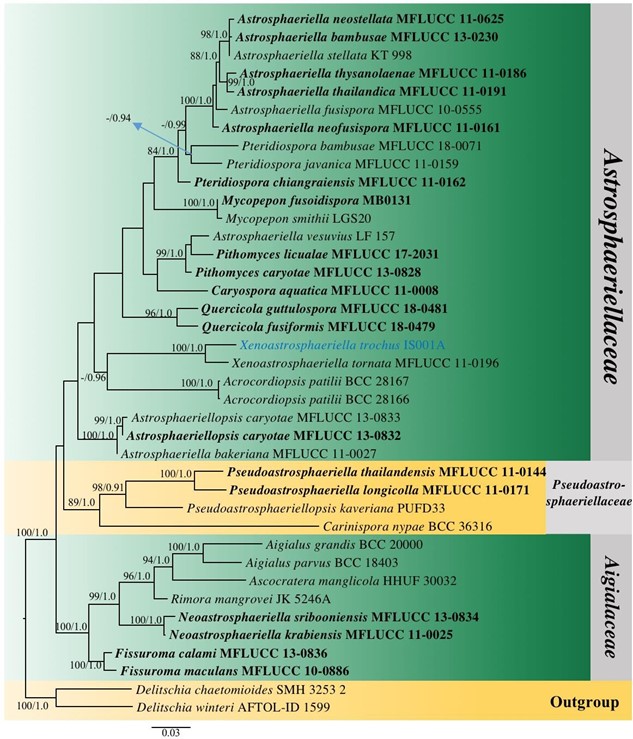Astrosphaeriellaceae Phookamsak & K.D. Hyde, Fungal Divers 74: 161 (2015).
= Caryosporaceae Huang Zhang, K.D. Hyde & Ariyaw.
Index Fungorum number: IF 551632; MycoBank number: MB 551632; Facesoffungi number: FoF 01221, 111 species.
Saprobic or parasitic on bamboo, palms, Quercus sp., or stout grasses. Sexual morph: Ascostromata dark opaque, solitary to gregarious, erumpent to superficial, conical or mammiform, with ruptured, reflexed, stellate, host remnants, around the base, uni-loculate, glabrous, brittle, carbonaceous, with minute apical ostiole. Peridium thick-walled, of unequal thickness, poorly developed at the base, composed of thick, opaque and melanized cells, with palisade-like cells at the rim. Hamathecium comprising dense, an astomosing, trabeculate pseudoparaphyses, embedded in a hyaline gelatinous matrix. Asci 8-spored, bitunicate, fissitunicate, cylindrical to cylindric- clavate, pedicellate, apically rounded with an ocular chamber, or J- subapical ring. Ascospores overlapping 1–2-seriate, subfusoid to fusiform, obclavate to ellipsoidal, or lemoniform, hyaline to pale brown, or reddish brown, septate, constricted at the septum, smooth-walled, with or without appendages and mucilaginous sheath. Asexual morph: Coelomycetous or hyphomycetous (Pithomyces). Conidiomata pycnidial, scattered, solitary, superficial, conical to hemisphaerical, or globose, uni-to bi-loculate, indistinctly ostiolate. Pycnidial walls thin to thick-walled, composed of several layers of dark brown to black cells of textura angularis to textura intricata. Conidiophores reduced to conidiogenous cells. Conidiogenous cells mono or polyblastic or holoblastic, rhexolytic or phialidic, hyaline to pale brown, cylindrical or cylindric-clavate or ampulliform, septate or aseptate. Conidia globose to obovate, hyaline, aseptate to 3–5-spetate, smooth, verruculose, or spinulose.
Type – Astrosphaeriella Syd. & P. Syd.
Notes – Phookamsak et al. (2015b) established Astrosphaeriellaceae to accommodate Astrosphaeriella (Sydow & Sydow 1913a) and Pteridiospora (Penzig & Saccardo 1897). Wanasinghe et al. (2018a) placed Astrosphaeriellopsis in Astrosphaeriellaceae based on the well- supported phylogenetic results. Pithomyces is similar to some astrosphaeriella-like taxa. Several strains of Pithomyces containing the ex-type P. flavus form a well-supported monophyletic group within Astrosphaeriellaceae in Wanasinghe et al. (2018a). Thus, Pithomyces was positioned in Astrosphaeriellaceae, and this opinion was followed by Wijayawardene et al. (2018). Javaria was treated as a synonym of Astrosphaeriella (Hyde & Fröhlich 1998), and there is no molecular data for this genus to confirm its phylogenetic position, so Javaria may still be a unique genus and it has been accepted into this family by Wijayawardene et al. (2018). Another two new genera Quercicola and Xenoastrosphaeriella were introduced into the family by Jayasiri et al. (2019). Liu et al. (2018b) studied the phylogeny of Mycopepon Boise and suggested the genus should be a member of Astrosphaeriellaceae. Thus, there are eight genera included in Astrosphaeriellaceae viz. Astrosphaeriella, Astrosphaeriellopsis, Javaria, Mycopepon, Pithomyces, Pteridiospora, Quercicola and Xenoastrosphaeriella. Previously Astrosphaeriellaceae was recognized to have only coelomycetous asexual morphs, however, Wanasinghe et al. (2018a) emended the asexual morph of this family and suggested that the family should accommodate both coelomycetous and hyphomycetous asexual morphs due to the hyphomycetous asexual morph of Pithomyces discovered. Caryosporaceae was introduced to accommodate Caryospora and Acrocordiopsis based on combined LSU, rpb-2, SSU and tef1 sequence data of Pleosporales (Ariyawansa et al. 2015a). However, in our phylogenetic analysis, Caryospora aquatica and Acrocordiopsis patilii are included in Astrosphaeriellaceae group (Fig. 53). Further studies are needed to resolve this problem.

Figure 53 – Phylogram generated from maximum likelihood analysis (RAxML) of genera in Astrosphaeriellaceae based on LSU, rpb-2, SSU and tef1 sequence data. Maximum likelihood bootstrap values equal or above 70 %, Bayesian posterior probabilities equal or above 0.90 (MLBS/PP) are given at the nodes. An original isolate number is noted after the species name. The tree is rooted to Delitschia chaetomioides (SHM 3253.2) and D. winteri (AFTOL-ID 1599). The ex-type strains are indicated in bold. Newly sequence is in blue. Hyphen (-) represents support values below 70 % MLBS and 0.90 PP.
Genera
